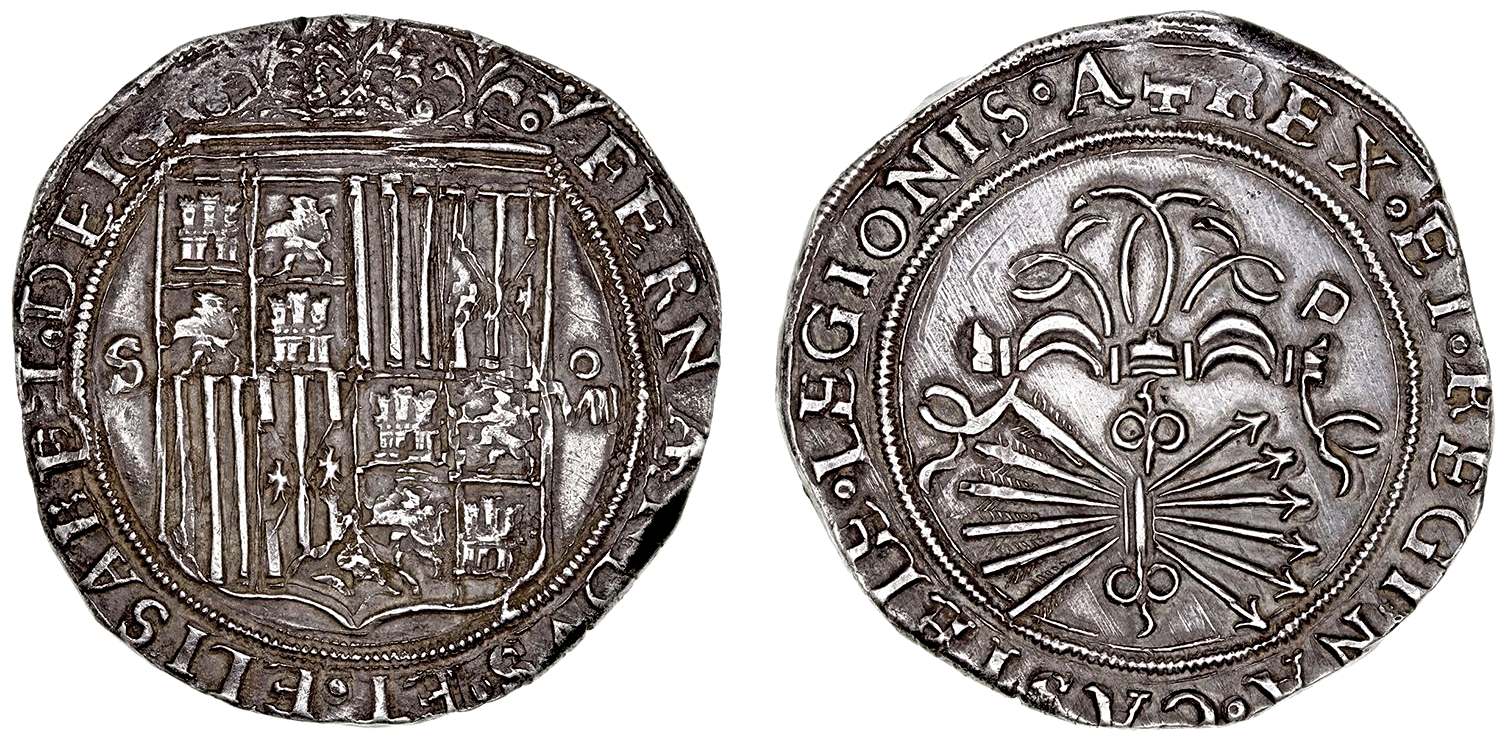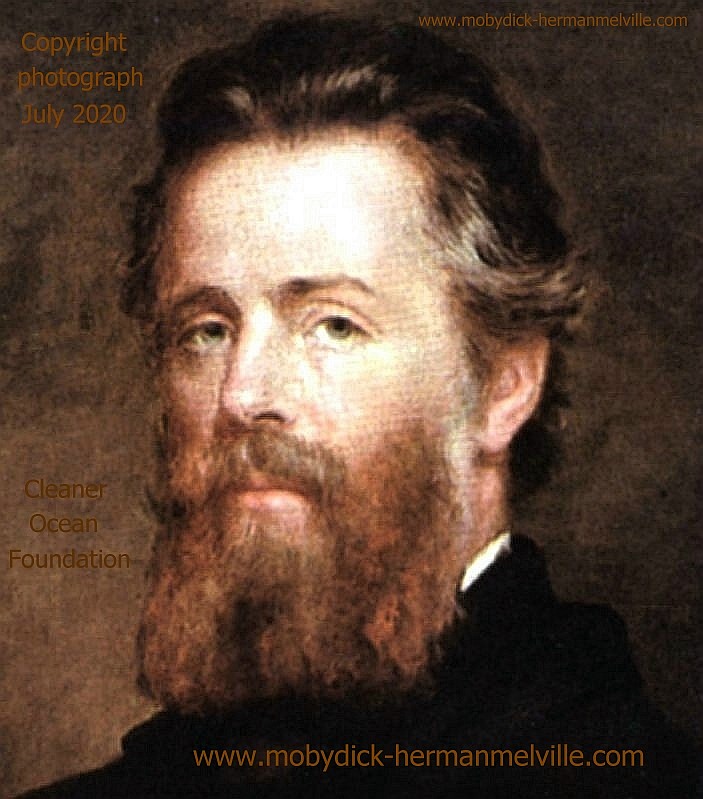
An
8-real, or one peso silver coin from 1497
Pieces
of Eight, or Spanish dollars do not feature in Moby
Dick, rather unusually. Herman
Melville resisted that temptation, only working a Doubloon
into the plot.
The Spanish dollar, also known as the piece of eight (in Spanish: Real de a ocho, Peso duro, Peso fuerte or Peso), is a silver coin of approximately 38 mm (1.5 in) diameter worth eight Spanish reales. It was minted in the Spanish Empire following a monetary reform in 1497.
The Spanish dollar was widely used by many countries as the first international currency because of its uniformity in standard and milling characteristics. Some countries countersigned the Spanish dollar so it could be used as their local currency.
The Spanish dollar was the coin upon which the original United States dollar was based, and it remained legal tender in the United States until the Coinage Act of 1857. Because it was widely used in Europe, the Americas, and the Far East, it became the first world currency by the late 18th century. Aside from the U.S. dollar, several other currencies, such as the Canadian dollar, the Japanese yen, the Chinese yuan, the Philippine peso, and several currencies in the rest of the Americas, were initially based on the Spanish dollar and other 8-real coins. Diverse theories link the origin of the "$" symbol to the columns and stripes that appear on one side of the Spanish dollar.
The term peso was used in Spanish to refer to this denomination, and it became the basis for many of the currencies in the former Spanish colonies, including the Argentine, Bolivian, Chilean, Colombian, Costa Rican, Cuban, Dominican, Ecuadorian, Guatemalan, Honduran, Mexican, Nicaraguan, Paraguayan, Philippine, Puerto Rican, Peruvian, Salvadoran, Uruguayan, and Venezuelan pesos. Of these, "peso" remains the name of the official currency in Argentina, Chile, Colombia, Cuba, Dominican Republic, Mexico, Philippines, and Uruguay.
Millions of Spanish dollars were minted over the course of several centuries. They were among the most widely circulating coins of the colonial period in the Americas, and were still in use in North America and in South-East Asia in the 19th century.
SPAIN
After the introduction of the Guldengroschen in Austria in 1486, the concept of a large silver coin with high purity (sometimes known as "specie" coinage) eventually spread throughout the rest of Europe. Monetary reform in Spain brought about the introduction of an 8-real (or 1-peso) coin in 1497, minted to the following standards-
In 1497: 8 3⁄8 dollars to a Castilian mark of silver (230.0465 grams), 134⁄144 or 0.9306 fine (25.563 g fine silver)
In 1728: $8.50 to a mark, 11⁄12 or 0.9167 fine (24.809 g fine silver)
In 1772: $8.50 to a mark, 130⁄144 or 0.9028 fine (24.443 g fine silver; but true fineness 1772–1821 believed to be only 0.89.
This was supplemented In 1537 by the
gold escudo, minted at 68 to a mark of gold 0.917 fine (fineness reduced to 0.906 in 1742 and 0.875 in 1786). It was valued at 15–16 reales or approximately 2 dollars. The famed Gold Doubloon was worth 2 escudos or approximately 4 dollars.
From the 15th to the 19th centuries the coin was minted with several different designs at various mints in Spain and the New World, having gained wide acceptance beyond Spain's borders. Thanks to the vast silver deposits that were found mainly in Potosí in modern-day Bolivia and to a lesser extent in Mexico (for example, at Taxco and Zacatecas), and to silver from Spain's possessions throughout the Americas, mints in Mexico and Peru also began to strike the coin. The main New World mints for Spanish dollars were at Potosí, Lima, and Mexico City (with minor mints at Bogotá, Popayán, Guatemala City, and Santiago), and silver dollars from these mints could be distinguished from those minted in Spain by the Pillars of Hercules design on the reverse.
The dollar or peso was divided into 8 reales in Spanish Latin America until 19th century when the peso was divided instead into 100 centavos.
USA
The Coinage Act of 1792 created the United States Mint and initially defined the United States dollar at par with the Spanish dollar due to its international reputation:
By far the leading specie coin circulating in America was the Spanish silver dollar, defined as consisting of 387 grains of pure silver. The dollar was divided into "pieces of eight," or "bits," each consisting of one-eighth of a dollar. Spanish dollars came into the North American colonies through lucrative trade with the West Indies. The Spanish silver dollar had been the world's outstanding coin since the early 16th century, and was spread partially by dint of the vast silver output of the Spanish colonies in Latin America. More important, however, was that the Spanish dollar, from the 16th to the 19th century, was relatively the most stable and least debased coin in the Western world.
The Coinage Act of 1792 specified that the U.S. dollar would contain 371.25 grains (24.057 g) pure or 416 grains (26.96 g) standard
silver. This specification was based on the average weight of a random selection of worn Spanish dollars which Alexander Hamilton ordered to be weighed at the Treasury. Initially this dollar was comparable to the 371–373 grains found in circulating Spanish dollars and aided in its exportation overseas. The restoration of the old 0.9028 fineness in the Mexican peso after 1821, however, increased the latter’s silver content to 24.44 g and reduced the export demand for US dollars.
Before the American Revolution, owing to British mercantilist policies, there was a chronic shortage of British currency in Britain's colonies. Trade was often conducted with Spanish dollars that had been obtained through illicit trade with the West Indies. Spanish coinage was legal tender in the United States until the Coinage Act of 1857 discontinued the practice. The pricing of equities on U.S. stock exchanges in 1⁄8-dollar denominations persisted until the New York Stock Exchange converted first to pricing in sixteenths of a dollar on 24 June 1997, and shortly after that, to decimal pricing.
PIRACY & FICTION
In modern pop culture and fiction, "pieces of eight" are most often associated with the popular notion of
pirates, such as Blackbeard
(Edward Teach).
In Robert Louis
Stevenson's Treasure
Island, Long John Silver's parrot had apparently been trained to cry out, "Pieces of eight!" This use tied the coin (and parrots) to fictional depictions of pirates. Deriving from the wide popularity of this book, "Pieces of eight" is sometimes used to mean "money" or "a lot of money", regardless of specific denomination, and also as a synonym for treasure in general.
In Pirates of the
Caribbean: At World's End the Pirate Lords must meet together by presenting the "Nine Pieces of Eight", since these Pieces were used to seal the goddess Calypso in her human form by the first Brethren Court. As the Pirate Lords were, at the time of sealing Calypso into her human form, too poor to offer real Spanish dollars, they opted to use personal talismans instead, except for the "ninth piece of eight" (Jack Sparrow's), which was an actual piece of eight that is hanging off his bandana in all movies, up to its destruction in the third film.
In Neal Stephenson's The Baroque Cycle numismatics, gold and pieces of eight are an integral part of the plot.
In Daniel
Defoe's Robinson Crusoe, Pieces of Eight are also mentioned among the types of currency that the title character encounters.
Pieces of eight are the currency used in the video game Puzzle Pirates and in the Monkey Island game series.
Pieces of Eight is the eighth studio album and second concept album by Styx, released on 1 September 1978.
In May of 1987, Neil Peart of Rush recorded a flexi-disc for Modern Drummer magazine titled, Pieces of Eight.

Herman
Melville was the author of what we'd now consider an illegal activity,
the commercial hunting of whales for oil and meat.
Please use our
A-Z INDEX to
navigate this site

